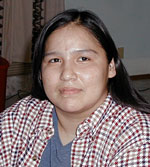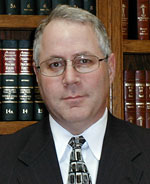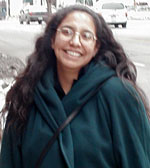| It's been more than a year since a United States Commission on Civil Rights report blasted race relations in South Dakota. Hundreds of Native Americans testified about abuses in law enforcement. The testimony echoed complaints brought before the commission in the mid-1970s, causing many to ask why there's been so little change.
 |
Frances Zephier, a member of the Yankton Sioux tribe, is disappointed the U.S. Commission on Civil Rights has little influence on the way Indians are treated in South Dakota.
(MPR Photo/Cara Hetland)
|
HOPES WERE HIGH in late 1999 when hundreds of Native Americans traveled to a Rapid City public hearing. Frances Zephier and her family hitched 250 miles from their Wagner, South Dakota homes to testify.
"When somebody says U.S. Commission on Civil Rights, you're thinking these people have control over our rights, they can hear us. They can do something," says Zephier.
Zephier, an enrolled member of the Yankton Sioux Tribe, testified that her 13-year-old daughter was raped by a federal law enforcement agent and there was no investigation into their claims.
"You told your story of your violations and someone else was telling their story too and when you cried, you cried together and you felt the sense of no justice," she says.
But now, a year after the commission issued its report, Zephier says that sense of injustice remains.
She says it would have been easier had they been told the commission had little real power other than to make recommendations. The report contains a very carefully worded critique of race relations in South Dakota, and a lot of suggestions for change. Few have been realized.
The report was broadly criticized by law enforcement. Governor Bill Janklow called it "garbage." The Chair of the State Advisory Committee for Civil Rights, Marc Feinstein, says the recommendations are sound and he wants more state cooperation.
"We called on the state and the governor to organize a task force to hear what are the real perceptions and the real problems that are out there. The governor flatly refused," says Feinstein.
Feinstein says with little funding and no enforcement powers, there's little else the state advisory committee can do.
 |
Marc Feinstein chairs the South Dakota Advisory Committee for Civil Rights. A report concerning the treatment of Indians in South Dakota, issued by his committee in 2000, differs little from one released in 1977. Compare them.
|
The same perceptions by Native Americans were presented in 1975 at a joint hearing for tribal members in both North and South Dakota. This came on the heels of a standoff at Wounded Knee, South Dakota where two FBI agents were killed and several Native Americans died from crossfire. Frances Zephier's father, an active member of the American Indian Movement testified at that hearing.
Zephier says there's a familiar tension within her own Yankton Sioux tribe in Charles Mix County. For years the state and tribe have been fighting over jurisdictional lines. A U.S. Supreme Court decision in 1998 put an area of what had been reservation land under the state's control. The state found about 2,000 outstanding arrest warrants for the area and reactivated them. Law enforcement was accused of stopping Indians just to run a check for outstanding warrants. Native Americans cried racial profiling, while law enforcement says it was just doing its job.
Ray Westendorf is the Charles Mix County Sheriff. "I don't know of anybody that's gotten stopped because of their race or ethnic background. There's one guy that's Mexican that lives here and he's been around here and we know him. He's been arrested so many times and we know he doesn't have a license, so if you see him driving you know he's breaking the law. It's not because he's a Mexican, it's because he doesn't have a drivers license that you stop him," say Westendorf.
The Charles Mix County State's Attorney put a freeze on all outstanding warrants for two months in order for tribal leaders to encourage its members to come forward and resolve arrest warrants on their own. Some say the improved communication eased the tense situation.
Both the 1977 and 2000 Civil Rights reports recommended the hiring of more Native American officers. The theory is if there were more Native American cops, communication would improve and cultural differences would disappear. Not true, says Steve Counoyer Sr. The 73-year-old Yankton Sioux tribal elder says there's a level of mistrust that's not easily erased.
 |
"The racism is blatant - in your face."
Lolita Spotted Thunder Moreno is the community relations coordinator for the Minneapolis Department of Civil Rights, and an enrolled member of the Oglala Sioux. She says there are some towns in South Dakota she avoids completely.
(MPR Photo/Cara Hetland)
|
"When you go on to the county or state payroll, the Indians back off because they don't trust you any more. That guy is on the other side, can't tell him nothing anymore. It's just that thing, that Native American thing, that white thing," says Counoyer.
There is an effort to improve communication in Charles Mix County. The tribe and county officials recently signed an agreement, a wish list of sorts, of common goals and solutions they'll work together on. And local, tribal and federal law enforcement officers formed a working group to discuss traffic stops, crime and even ways to keep kids out of trouble.
While law enforcement and reservation leaders are working together, some say there's still an overall anti-Indian feeling in the state. It's even apparent at local gas stations, says Lolita Spotted Thunder Moreno. The community relations coordinator for the Minneapolis Department of Civil Rights is an enrolled member of the Oglala Sioux Tribe. She was raised in the San Francisco Bay area but spent her summers with relatives in South Dakota. She owns a home on the Pine Ridge reservation but refuses to raise her children there.
"The racism - it's blatant - in your face," she says.
Moreno says there are certain stores she avoids along her trek across South Dakota and some towns she won't even drive through. It's from years of experience she says, but she doesn't ask for much.
"They can at least smile and talk to me like they talk to every body else. Be courteous to me like they are to other new comers."
Understanding cultural differences, learning about the history of Native Americans, and showing common courtesies, says Mareno, are all essential parts to eliminate discrimination in our society.
The department of justice is studying civil rights issues throughout all of Indian Country. It's distributing money for more police officers and court advocates. There's talk that the U.S. Commission on Civil Rights will investigate housing and fairness in the courts for Native Americans. There's no indication if they'll return to South Dakota any time soon.
|